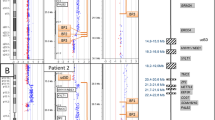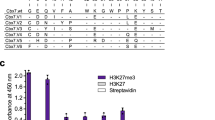Abstract
An increasing body of evidence indicates that submicroscopic gene dose alterations may cause mental impairment and malformations. During the last decade, comparative genomic hybridization (CGH) has become a useful tool in the detection and mapping of chromosome aberrations. Modifications of CGH with increased resolution down to 3–5 Mb have been reported and CGH is now offered as a diagnostic procedure in the evaluation of patients with idiopathic mental retardation (MR). In order to increase the resolution, we modified the CGH protocol using freshly prepared high-quality metaphase slides and chemical labeling, and tested the method on a set of patients with well-defined submicroscopic chromosome abnormalities with confirmed size 1.3–20.5 Mb. Subsequently, a completely blinded test was performed to compare the performance of the chemical labeling CGH to the commercially available HR-CGH. Using the two different CGH methods, we were able to detect chromosome imbalances down to 2–3 Mb approximately. The HR-CGH method detected all aberrations >6 Mb and a few smaller, while the modified CGH method was able to detect all but three aberrations >1.8 Mb. The modified CGH method was superior in the detection of terminal imbalances, while the HR-CGH software was more successful in the detection of imbalances located very close to the centromeric regions. In conclusion, the resolution of metaphase CGH may be as high as 2–3 Mb but is most likely depending on the chromosomal region involved, a clear limitation when used as a screening method for chromosome aberrations in patients with idiopathic MR.
Similar content being viewed by others
Log in or create a free account to read this content
Gain free access to this article, as well as selected content from this journal and more on nature.com
or
References
Xu J, Chen Z : Advances in molecular cytogenetics for the evaluation of mental retardation. Am J Med Genet 2003; 117C: 15–24.
Rosenberg MJ, Vaske D, Killoran CE et al: Detection of chromosomal aberrations by a whole-genome microsatellite screen. Am J Hum Genet 2000; 66: 419–427.
Rio M, Molinari F, Heuertz S et al: Automated fluorescent genotyping detects 10% of cryptic subtelomeric rearrangements in idiopathic syndromic mental retardation. J Med Genet 2002; 39: 266–270.
Joly G, Lapierre JM, Ozilou C et al: Comparative genomic hybridisation in mentally retarded patients with dysmorphic features and a normal karyotype. Clin Genet 2001; 60: 212–219.
Kirchhoff M, Rose H, Lundsteen C : High resolution comparative genomic hybridisation in clinical cytogenetics. J Med Genet 2001; 38: 740–744.
Sanlaville D, Romana SP, Lapierre JM et al: A CGH study of 27 patients with CHARGE association. Clin Genet 2002; 61: 135–138.
Ness GO, Lybaek H, Houge G : Usefulness of high-resolution comparative genomic hybridization (CGH) for detecting and characterizing constitutional chromosome abnormalities. Am J Med Genet 2002; 113: 125–136.
Kallioniemi OP, Kallioniemi A, Piper J et al: Optimizing comparative genomic hybridization for analysis of DNA sequence copy number changes in solid tumors. Genes Chromosomes Cancer 1994; 10: 231–243.
Heetebrij RJ, Talman EG, Velzen MA et al: Platinum(II)-based coordination compounds as nucleic acid labeling reagents: synthesis, reactivity, and applications in hybridization assays. Chembiochem 2003; 4: 573–583.
Anderlid BM, Schoumans J, Anneren G et al: Subtelomeric rearrangements detected in patients with idiopathic mental retardation. Am J Med Genet 2002; 107: 275–284.
Anderlid BM, Schoumans J, Hallqvist A et al: Cryptic subtelomeric 6p deletion in a girl with congenital malformations and severe language impairment. Eur J Hum Genet 2003; 11: 89–92.
Schoumans J, Anderlid BM, Blennow E : The performance of CGH-array for the detection of cryptic constitutional chromosome imbalances. J Med Genet 2004; 41 (3): 203–207.
Buckley PG, Mantripragada KK, Benetkiewicz M et al: A full-coverage, high-resolution human chromosome 22 genomic microarray for clinical and research applications. Hum Mol Genet 2002; 11: 3221–3229.
Chai JH, Locke DP, Greally JM et al: Identification of four highly conserved genes between breakpoint hotspots BP1 and BP2 of the Prader–Willi/Angelman syndromes deletion region that have undergone evolutionary transposition mediated by flanking duplicons. Am J Hum Genet 2003; 73: 898–925.
Kallioniemi A, Kallioniemi OP, Sudar D et al: Comparative genomic hybridization for molecular cytogenetic analysis of solid tumors. Science 1992; 258: 818–821.
Flint J, Knight S : The use of telomere probes to investigate submicroscopic rearrangements associated with mental retardation. Curr Opin Genet Dev 2003; 13: 310–316.
Kirchhoff M, Gerdes T, Maahr J et al: Deletions below 10 megabasepairs are detected in comparative genomic hybridization by standard reference intervals. Genes Chromosomes Cancer 1999; 25: 410–413.
Piper J, Rutovitz D, Sudar D et al: Computer image analysis of comparative genomic hybridization. Cytometry 1995; 19: 10–26.
Ross R, Ross XL, Rueger B, Laengin T, Reske-Kunz AB : Nonradioactive detection of differentially expressed genes using complex RNA or DNA hybridization probes. Biotechniques 1999; 26: 150–155.
Tanke HJ, Wiegant J, van Gijlswijk RP et al: New strategy for multi-colour fluorescence in situ hybridisation: COBRA: COmbined Binary RAtio labelling. Eur J Hum Genet 1999; 7: 2–11.
van Gijlswijk RP, Talman EG, Janssen PJ et al: Universal linkage system: versatile nucleic acid labeling technique. Expert Rev Mol Diagn 2001; 1: 81–91.
Snijders AM, Nowak N, Segraves R et al: Assembly of microarrays for genome-wide measurement of DNA copy number. Nat Genet 2001; 29: 263–264.
Acknowledgements
We thank Isabel Tapia Páez for the chromosome 22 specific array data. We also want to thank Resources for Molecular Cytogenetics, Bari, The Wellcome Trust Sanger Institute and BACPAC Resource Center, Children's Hospital Oakland Research Institute for providing BAC and PAC clones. This work was supported by funds from the Swedish Medical Research Council, Linnea and Jozef Carlsson Stiftelse and the Danish Medical Research Council.
Author information
Authors and Affiliations
Corresponding author
Rights and permissions
About this article
Cite this article
Schoumans, J., Nielsen, K., Jeppesen, I. et al. A comparison of different metaphase CGH methods for the detection of cryptic chromosome aberrations of defined size. Eur J Hum Genet 12, 447–454 (2004). https://doi.org/10.1038/sj.ejhg.5201175
Received:
Revised:
Accepted:
Published:
Issue date:
DOI: https://doi.org/10.1038/sj.ejhg.5201175
Keywords
This article is cited by
-
Non-homologous sex chromosomes of birds and snakes share repetitive sequences
Chromosome Research (2010)
-
Subtelomeric study of 132 patients with mental retardation reveals 9 chromosomal anomalies and contributes to the delineation of submicroscopic deletions of 1pter, 2qter, 4pter, 5qter and 9qter
BMC Medical Genetics (2005)
-
Genome-wide screening using array-CGH does not reveal microdeletions/microduplications in children with Kabuki syndrome
European Journal of Human Genetics (2005)



